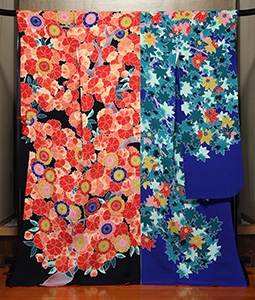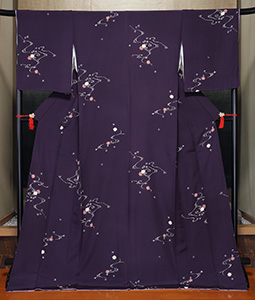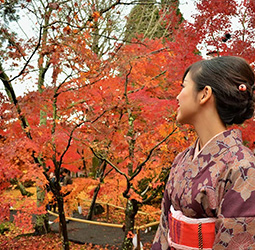
Woman wearing a white kimono with a pattern of a few autumn leaves and tied with a reddish obi sash 
A kimono decorated with the ofu pattern, which shows cherry blossoms for spring and momiji maple leaves for autumn 
A kimono decorated with the autumnal Tatsutagawa motif 
Close-up of the Tatsutagawa motif on a kimono 
A woman wearing a kimono tied with a red-colored obi sash evoking the autumn leaves
September 2021
Kimono with Autumn Leaf Patterns

Famous for its gorgeous colors and patterns, the kimono, Japan’s traditional garment, uses various means to express the passage of the four seasons. In the autumn, kimono with red leaf patterns are especially beautiful.

The kimono, Japan’s traditional garment, is fashioned from delicate woven fabrics and dyed silk.* Many of the patterns use kacho-fugetsu (lit. flowers, birds, wind and moon) motifs to express the four seasons.
Takada Hiroshi, the third-generation proprietor of Komonya Takadakatsu, a kimono manufacturer and wholesale business that also reproduces traditional patterns, comments, “The shape of the kimono remains essentially the same irrespective of the season. Japanese people have traditionally expressed the four seasons through patterns and colors in the kimono within the constraints of this shape that remains the same.”
The predominant motifs are plants that evoke each of the four seasons, typically cherry blossoms in spring, morning glory in summer, momiji (red maple leaves) and chrysanthemum in autumn, and pine and bamboo in winter.
Among these motifs, the momiji is featured in a variety of patterns that can be worn nearly all year round. For example, kimono with a pattern of ao-momiji, fresh green maple leaves that have not yet turned red, can be worn from May through the summer. Red momiji leaves, or the Tatsutagawa motif, a design that depicts scattered momiji floating on running water, are standard patterns for kimono worn in the autumn. The Tatsutagawa motif is derived from a waka poem by the ninth century poet Ariwara no Narihira. The poem describes how the water of the Tatsutagawa river, a famous spot for viewing the autumn leaves in Nara Prefecture south of Kyoto, is colored red with scattered momiji leaves.**


The ofu pattern, which is decorated with cherry blossoms for spring and red momiji leaves for autumn, can be worn in both seasons.
In addition to the patterns, the obi sash or accessories can also be used to express the seasons.
Takada continues, “Other ways to express autumn are, for example, to choose a red-colored obi (kimono sash belt), which evokes autumn leaves, to accompany a cherry-colored kimono, or to use an obidome (ornament worn over an obi) in the shape of an autumn leaf as an accessory to a chic plain kimono. One of the joys of wearing kimono is to find various ingenious ways to match your outfit to the season.”

It is fair to say that arranging the kimono to express a sense of the season is an expression of the Japanese spirit that loves nature and seeks to coexist with it.
* Some famous textiles in Japan are Nishijin woven fabric from Kyoto, Yuzen dyed fabric from Kyoto, and Kaga Yuzen dyed fabric from Ishikawa Prefecture.
** Such beauty unheard of/even in the age of the raging gods—/the Tatsuta River/tie-dyeing its waters/in autumnal colors. Translation by Peter MacMillan, One Hundred Poets, One Poem Each (https://www.gov-online.go.jp/eng/publicity/book/hlj/html/202010/202010_02_en.html)


